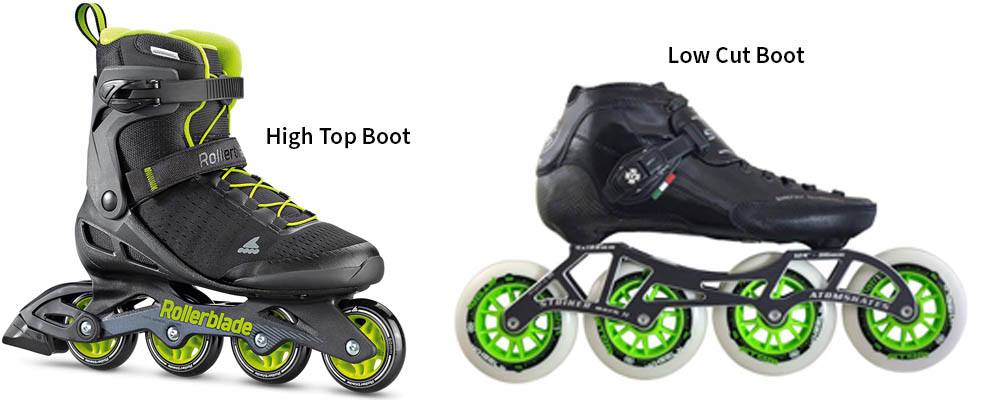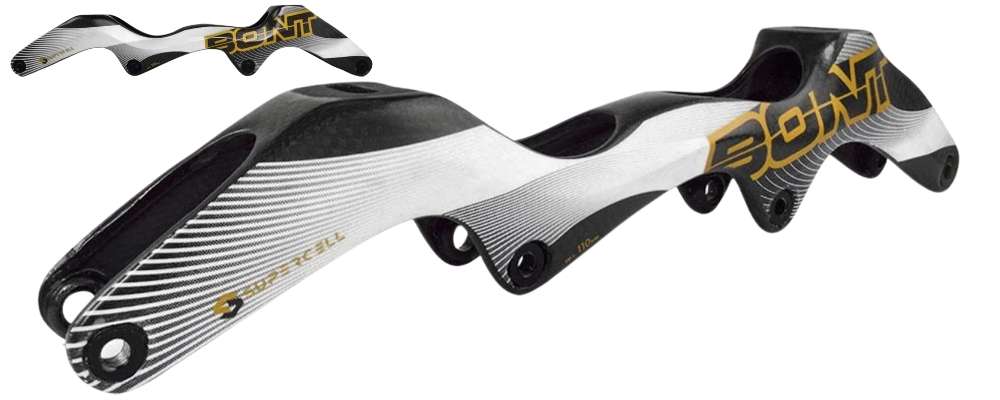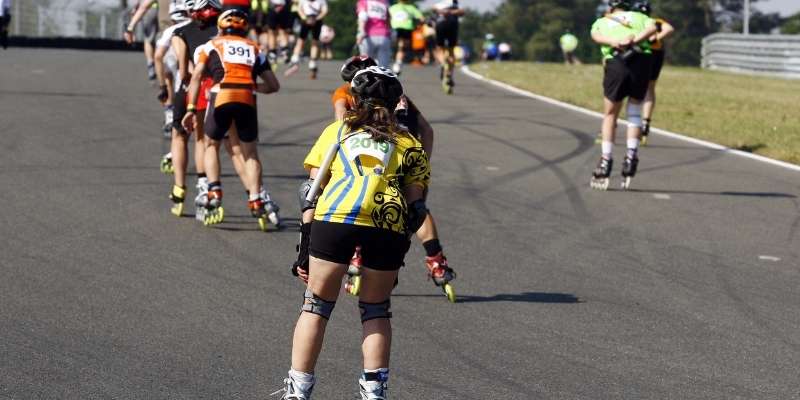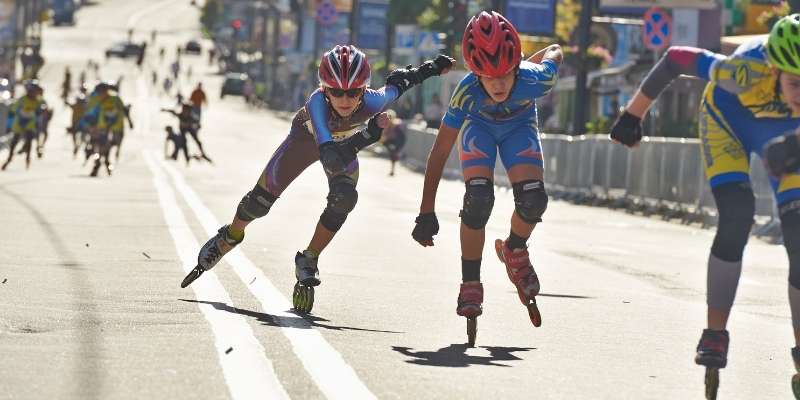Inline speed skating is a competitive form of inline skating in which participants attempt to skate as fast as possible over a set distance. Like ice skating, inline skating requires strong technique and stamina, as well as a good understanding of racing tactics.
Speed skating is an international sport governed by the International Skating Union (ISU). National governing bodies exist in over 60 countries worldwide. There are numerous racing formats including sprint races, elimination races, distance races, and team relay races.

Speed skating is an exciting and challenging sport that can be enjoyed by skaters of all ages and abilities. If you’re looking to get involved in inline speed skating, this ultimate guide will teach you everything you need to know!
Speed Skates: Not Your Everyday Rollerblades

Inline speed skates are not your everyday roller skates, and they’re a lot faster than traditional quad roller skates. They are purpose-built for racing and have a number of key features that set them apart from recreational skates.
The most obvious difference is in the inline speed skate wheels. Speed skates have much larger wheels than recreational skates, typically ranging from 80-100mm in diameter. The larger wheels provide less rolling resistance and allow the skater to reach higher speeds.

Speed skates also have a shorter, more compact frame than recreational skates. This gives the skater a lower center of gravity and makes them more stable and agile at high speeds.
The boots of inline roller skates are also different than what you’ll find in recreational skating. They are usually made from stiffer materials such as carbon fiber or leather to provide support and energy transfer when skating. The lacing system is also designed to be tighter and more secure, to prevent the foot from moving around inside the boot when skating at high speeds.
Unlike other skating disciplines, speed skating does not generally make use of brakes. This is because brakes can slow the skater down and cause them to lose balance. Instead, speed skaters rely on their momentum to keep moving forward and use their body weight to control their speed when going around turns. While this may seem like a dangerous way to skate, an experienced speed skater can maintain control and avoid accidents.
All of these parts have an enormous impact on your race times. Let’s talk in more detail about what makes each component unique to speed skating.
Parts of a Speed Skate
The main components of an inline speed skate are the boot, frame, bearings, and wheels. There are tons of options for each component, so here are some key considerations for skaters of any level.
Boot

The boot is the most important part of the skate and has the biggest impact on your roller skating performance. It needs to be stiff enough to provide support when cornering and accelerating, but not so stiff that it limits your range of motion. The boot also needs to be comfortable enough to wear for long periods of time, as speed skating races can last anywhere from thirty seconds to several minutes.
The two most popular materials for speed skating boots are carbon fiber and polyurethane leather. Carbon fiber is stiffer than leather and provides better support, but it is also more expensive. Leather is more comfortable than carbon fiber and is often used in lower-priced inline skates and rollerblades. Some boots incorporate fiberglass or Kevlar into the design to provide additional stiffness without adding significant weight.
The lacing system of a speed skate is also important. The laces need to be tight enough to keep the foot from moving around inside the boot, but not so tight that they restrict blood flow. Many speed skaters use snaps and straps in addition to their laces to provide extra support.
Frame

The frame connects your wheels to the boot and provides a platform for the skater to push against. It needs to be strong enough to transfer energy efficiently, but durable enough to withstand the rigors of racing.
The most popular materials for speed skating frames are aluminum, magnesium, and carbon fiber. Aluminum is stiffer than carbon fiber and provides better support, but it is also heavier. Carbon fiber is lighter than aluminum and is often used in racing inline skates for sprinting.
The length and width of the frame also impact your skating performance. A shorter frame is more maneuverable than a longer frame, but it is also less stable. A longer frame is the opposite: far more stable, but much less maneuverable. A wider frame provides more stability, but it is also heavier. A narrower frame is lighter but sacrifices that stability. As you might imagine, frame size choice is a highly personalized decision that leaves speed skaters bickering and competing to out-optimize the competition.
Bearings

The bearings are the small metal balls that allow your wheels to rotate. Bearings are measured by their diameter. The most common diameter that almost all wheels take today are 8mm.
The most popular bearing sizes for outdoor speed skating are 608 and 688. These bearings fit 8mm axles, but the 688 bearings are smaller. Some skates require 7mm bearings, but these are less common—with the exception of the popular BONT Speed Skates, some of which use a special 7mm 167 bearing.
I have an article all about roller skate bearings where you can learn a lot more.
Wheels

Speed skating wheels get a lot of attention because they have the biggest impact on your skating performance. The faster you can make your wheels spin, the faster you will skate. But speed is not the only consideration when choosing a wheel. You also need to consider the hardness of the wheel, the width of the wheel, and the contact patch.
Speed skating wheels are made from polyurethane, which comes in a variety of hardness ratings. Softer wheels provide more grip but wear down faster. Harder wheels slide more easily but don’t grip the floor as well.
I have other articles on inline speed skate wheels and roller skate wheels if you want to learn even more.
Choosing the Right Inline Speed Skates

There are a few things to consider when choosing inline speed skates. The most important factor is your skating ability. If you’re a beginner, it’s best to start with an entry-level skate that is designed for beginners. These skates will have a lower price point and will offer features that make them easier to skate.
As you progress, you can move up to a more advanced skate that is designed for racing. These skates will be more expensive but will offer better performance in terms of speed and maneuverability.
Another important factor to consider is the type of skating you want to do. If you’re interested in sprint racing, you’ll need a different skate than someone who wants to race long distances. Sprint skates are typically lighter and have a shorter frame, while distance skates are slightly larger to improve durability for long races.
When you’re ready to buy, it’s important to find a reputable dealer who can help you choose the right skate for your needs. It’s also a good idea to try on different skates and ask for advice from experienced skaters before making your purchase.
Speed Skating Race Formats

Inline speed skating is an Olympic sport that’s raced in a variety of formats. However, there are two main types of races: short track and long track.
Short-track racing is held on a smaller, oval-shaped rink that’s 364 meters long. The races are shorter in distance and there are more skaters on the ice at one time. This makes for a more chaotic and exciting race.
Long track skating is held on a 400-meter oval rink. The races are longer in distance and there are fewer skaters in play, depending on the format. This results in a more strategic and tactical race.
Both short track and long track races can be held as either individual or team events. In an individual event, each skater races against the clock. Here are some of the details about popular racing formats.
Sprint

Just like sprint running, sprint races are short, fast, and all about explosive speed. They’re held over a distance of 100 or 300 meters.
The 100-meter sprint is the shortest and fastest race in inline speed skating. It’s all about acceleration. This is a single-lap race where skaters start from a standing position.
The 300-meter sprint is similar to the 100-meter sprint, but it’s more focused on reaching and maintaining top speeds.
Time Trial
The time trial is an individual race against the clock where skaters try to achieve the fastest time possible. Time trials are also held in 100m and 300m variations, but much longer distances can be skated as well. Some formats even measure how far a skater can cover over one or two days in a fantastic test of endurance.
Distance

As the name suggests, distance races are all about skating long distances. These races can range from 5km meters up to over 100km.
Distance races are typically held as individual events, but there are team formats as well. In a team event, skaters take turns racing around the track while the other members of the team rest. The team with the fastest combined time wins the race.
Criterium
While traditional skating races may have skaters complete a specified distance or number of laps, a criterium race focuses on skating for a certain amount of time. The skaters are typically given between 15 and 45 minutes before the bell is rung, signaling that the race is coming to an end. At this point, the skaters must complete one or two more laps around the course before they can cross the finish line.
Relays
Relays are a great way to get the entire team involved in the race. Each team is made up of two to four skaters, and each team member takes turns skating around the track. The first skater starts off strong and fast, hand-offs are made quickly and efficiently, and the last skater crosses the finish line with a burst of speed.
It’s a thrilling event to watch, and even more exciting to be a part of. Whether you’re racing in an outdoor or indoor skating event, mixed relay or single-sex event, inline speed skating relays are a great way to show off your skating skills.
Points

In points races, competitors earn points in a points race based on when they cross the finish line during each lap. Laps late in the race are worth more points, with the final lap being the most valuable. The aim of the game is to accumulate the most points, not necessarily to cross the finish line first.
This makes for an exciting and unpredictable race, as skaters jostle for position and try to make strategic moves to improve their chances of winning. Whether you’re a casual fan or a hardcore competitive inline skater, points races are always exciting to watch.
Elimination
In an elimination race, also known as the last man out, the hindmost skater is eliminated from the competition each time the pack of skaters completes a lap or when they complete certain specified lap numbers.
The group has usually been pared down to four or five skaters at one or two laps before the finish. At this point, the first across the finish line is the winner. These moderate-distance races are exciting to watch because it is unclear who will be eliminated next and who will ultimately come out victorious.
Points-Elimination
Points-elimination races are a type of racing that combines the best of both worlds: the excitement of an elimination race with the strategy of a points race. In a points-elimination race, riders accumulate points as they ride around the track, but they are also at risk of being eliminated if they fall behind a certain number of points. This creates an exciting and dynamic race where riders must think both tactically and strategically in order to succeed. Points-elimination races are becoming increasingly popular, as they offer something unique and exciting for both riders and spectators alike.

Marathon & Ultra-Marathon
Marathon and ultra-marathon inline skating races are some of the most grueling and challenging events in the sport. These long-distance races can range from 50km to over 200km, and require skaters to have both endurance and speed.
Ultra-marathon races are typically held as individual events, but there are team events as well. In a team event, each skater takes turns skating different legs of the course, with the aim being to complete the distance in the shortest possible time.
Marathon and ultra-marathon races are not for the faint of heart, but they are an exciting test of a skater’s abilities.
Inline Speed Skating Techniques

Once you have your skates, it’s time to start skating! Inline speed skating is a technical sport that takes practice and patience to master. Here are a few tips to help you get started.
Start slow
When you’re first learning, it’s important to go slowly and focus on your technique. As you become more comfortable, you can start to increase your speed.
Find your center of gravity
Inline skating is all about balance. The key to maintaining your balance is to find your center of gravity and keep your weight evenly distributed on both skates.
Use your hips
Your hips are the key to generating power when you skate. When you push off, make sure to use your hip muscles to generate the most power possible.
Pump your arms
As you skate, make sure to pump your arms back and forth. This will help you maintain your balance and generate more power.
Bend your knees
When you’re skating, it’s important to keep your knees bent. This will help you absorb shocks and maintain your balance.
Practice, practice, practice!
The only way to get better at inline skating is to practice. The more you skate, the better your technique will become.
During sprints, skaters need to take quick, sharp strides to get a jump start. Once they have achieved a good pace, they can then begin taking longer strides. While doing this, it is important for skaters to maintain good body posture. This will help them to keep their balance and avoid any accidents. With practice, inline speed skaters can reach speeds of up to 50 kilometers per hour.
Stuck trying to find a good spot to lace up your skates? Check out my list of the best places to practice roller skating.
Speed Racing Tactics
Inline racing is a bit like playing chess on wheels. Team members must work together, using their strengths and weaknesses to their best advantage, in order to win the race. Just as in marathon ice speed skating and road bicycle racing, there are different roles that team members can play in order to help their team succeed.
Skaters will often form packs or “pacelines” with one person leading and others following behind them so that they can save energy by matching their strides. This lets them make use of drafting, which is when one skater follows closely behind another so that they can benefit from the leading skater’s slipstream.

When it comes to tactics, there are a few things to keep in mind. First, always be aware of what is happening around you. Knowing where your opponents are and what they are doing is crucial to being able to make the right decisions. Second, always be thinking ahead. What is your next move? What are your opponents’ next moves? By being strategic, you can put yourself in a position to win.
Race Prep
As with any race, proper preparation is key to success. In the days leading up to a race, skaters need to make sure that they are properly fueled and hydrated. They should also do some light skating to stay warm and loose.
On the day of the race, it is important to have a good breakfast and to warm up properly. Skaters should also make sure that their skates are in good condition and that they have all the equipment they need. But that’s not all—here are some of your most important considerations before the big event.
Physical Fitness & Conditioning
Inline skating is a physically demanding sport. Skaters need to have good endurance, strength, and balance in order to be successful. A good way to train for inline skating is to cross-train with other activities such as running, cycling, and weightlifting. This will help to build the muscles needed for inline skating and improve your overall fitness.
Equipment Handling & Maintenance
Inline skaters need to have good equipment in order to be successful. This includes a good pair of inline skates, protective gear, and the right clothing. Skaters also need to know how to properly maintain their equipment. This means regularly cleaning and lubricating their skates and inspecting their equipment for any damage.
Rules & Procedures
Inline skating is governed by a set of rules and regulations. These rules are designed to keep inline skaters safe and to ensure fair competition. Skaters need to be familiar with the rules so that they can avoid any penalties or disqualifications.
Get Out There and Get Skating
Speed skating is an excellent aerobic workout that improves heart health, helps regulate blood sugar levels, and burns calories. If you’re looking for a new physical challenge, want to improve your fitness level, or just want to have some fun, speed skating may be the perfect sport for you.
Speed skating is a great way to get exercise and have fun. It is also a competitive sport that’s great for any wellness enthusiast, whether you’re racing for a medal or reaping the sport’s fitness benefits.
